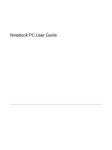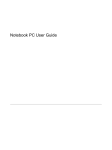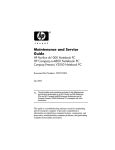Download Compaq Presario V3000 - Notebook PC User guide
Transcript
Multimedia User Guide © Copyright 2006 Hewlett-Packard Development Company, L.P. Microsoft and Windows are U.S. registered trademarks of Microsoft Corporation. The information contained herein is subject to change without notice. The only warranties for HP products and services are set forth in the express warranty statements accompanying such products and services. Nothing herein should be construed as constituting an additional warranty. HP shall not be liable for technical or editorial errors or omissions contained herein. First Edition: May 2006 Document Part Number: 412263-001 Table of contents 1 Multimedia hardware Using the optical drive .......................................................................................................................... 1 Identifying the installed optical drive .................................................................................... 1 Inserting an optical disc ....................................................................................................... 2 Removing an optical disc (with power) ................................................................................ 3 Removing an optical disc (without power) ........................................................................... 4 Using the media activity hotkeys .......................................................................................................... 5 Using the media button ........................................................................................................................ 6 Using the audio features ...................................................................................................................... 7 Using the audio-in (microphone) jack .................................................................................. 8 Using the audio-out (headphone) jack ................................................................................. 8 Adjusting the volume ........................................................................................................... 8 Using the video features ....................................................................................................................... 9 Using the external monitor port ............................................................................................ 9 Using the S-Video-out jack ................................................................................................ 10 2 Multimedia software Identifying preinstalled multimedia software ....................................................................................... 12 Installing multimedia software from a CD (select models only) .......................................................... 12 Using multimedia software ................................................................................................................. 12 Protecting playback ............................................................................................................................ 13 Protecting the CD or DVD write process ............................................................................................ 13 Changing DVD region settings ........................................................................................................... 14 Observing the copyright warning ........................................................................................................ 14 Index ................................................................................................................................................................... 15 ENWW iii iv ENWW 1 Multimedia hardware Using the optical drive The optical drive allows you to play, copy, and create CDs or DVDs, depending on the type of installed drive and installed software. Identifying the installed optical drive To view the type of optical drive installed in the computer: ▲ Select Start > My Computer. The type of optical drive installed in the computer is displayed under Devices with Removable Storage. ENWW Using the optical drive 1 Inserting an optical disc 1. Turn on the computer. 2. Press the release button (1) on the drive bezel to release the media tray. 3. Pull out the tray (2). 4. Hold the CD or DVD by the edges to avoid touching the flat surfaces, and position the disc over the tray spindle, with the label-side up. NOTE If the tray is not fully accessible, tilt the disc carefully to position it over the spindle. 5. Gently press the disc (3) down onto the tray spindle until the disc snaps into place. 6. Close the media tray. NOTE After you insert a disc, a short pause is normal. If you have not selected a default media player, an AutoPlay dialog box opens. It prompts you to select how you want to use the media content. 2 Chapter 1 Multimedia hardware ENWW Removing an optical disc (with power) If the computer is running on external or battery power: 1. Turn on the computer. 2. Press the release button (1) on the drive bezel to release the media tray, and then pull out the tray (2). 3. Remove the disc (3) from the tray by gently pressing down on the spindle while lifting the outer edges of the disc. Hold the disc by the edges and avoid touching the flat surfaces. NOTE If the tray is not fully accessible, tilt the disc carefully as you remove it. 4. ENWW Close the media tray and place the disc in a protective case. Using the optical drive 3 Removing an optical disc (without power) If external or battery power is unavailable: 1. Insert the end of a paper clip (1) into the release access in the front bezel of the drive. 2. Press in gently until the tray is released, and then pull out the tray (2). 3. Remove the disc (3) from the tray by gently pressing down on the spindle while lifting the outer edges of the disc. Hold the disc by the edges and avoid touching the flat surfaces. NOTE If the tray is not fully accessible, tilt the disc carefully as you remove it. 4. 4 Close the media tray and place the disc in a protective case. Chapter 1 Multimedia hardware ENWW Using the media activity hotkeys Media activity hotkeys are combinations of the fn key (1) and any of the 4 function keys. You can use these keys to control the play of an audio CD or a DVD that is inserted in the optical drive. NOTE To control the play of an inserted video CD, use the media activity controls in your video CD player program. ENWW ● To play, pause, or resume an inserted audio CD or a DVD, press fn+f9 (2). ● To stop an inserted audio CD or a DVD that is playing, press fn+f10 (3). ● To play the previous track of an audio CD or the previous chapter of a DVD that is playing, press fn+f11 (4). ● To play the next track of an audio CD or the next chapter of a DVD that is playing, press fn+f12 (5). Using the media activity hotkeys 5 Using the media button NOTE The media button functions vary, depending on the software installed on your computer. Refer to the QuickPlay online Help for details. If QuickPlay is installed and the computer is ● On, the media button opens a music program or the Media Menu allowing you to select a multimedia program. ● Off, the media button opens a music program or the Media Menu allowing you to select a multimedia program. NOTE Press the power button to exit the multimedia program. ● In standby, the media button resumes from standby into Microsoft® Windows®. If QuickPlay is not installed and the computer is ● On, the media button opens the default media player. ● Off, the media button does not function. ● In standby, the media resumes from standby into Windows. NOTE The media button does not affect the hibernation file or the procedure for restoring from hibernation. 6 Chapter 1 Multimedia hardware ENWW Using the audio features The following illustration and table describe the audio features of the computer. NOTE Your computer may look slightly different from the illustration in this section. ENWW Component Description (1) Speakers (2) Produce computer sound. (2) Volume mute button Mutes and restores computer sound. (3) Volume scroll zone Adjusts speaker volume. Slide your finger to the left to decrease volume and to the right to increase volume. (4) Audio-in (microphone) jack Connects an optional computer headset microphone, stereo array microphone, or monaural microphone. (5) Audio-out (headphone) jack Connects optional powered stereo speakers, headphones, ear buds, a headset, or television audio. Using the audio features 7 Using the audio-in (microphone) jack The computer is equipped with a microphone jack that supports an optional monaural (single sound channel) microphone. Select models support a stereo (dual sound channel) microphone. When connecting a microphone to the microphone jack, use a microphone with a 3.5-mm plug. Using the audio-out (headphone) jack WARNING! To reduce the risk of personal injury, adjust the volume before putting on headphones, earbuds, or a headset. CAUTION To prevent possible damage to an external device, do not plug a single sound channel (monaural) connector into the headphone jack. In addition to connecting headphones, the headphone jack is used to connect the audio input function of an audio/video device such as a television or VCR. When connecting a device to the headphone jack, use only a 3.5-mm stereo plug. NOTE When a device is connected to the headphone jack, the internal speakers are disabled. Adjusting the volume You can adjust the volume using the following controls: ● ● Computer volume buttons: ● To mute or restore volume, press the volume mute button. ● To decrease the volume, slide your finger across the volume scroll zone from right to left. Alternatively, you can tap the left half of the scroll zone to decrease the volume. ● To increase the volume, slide your finger across the volume scroll zone from left to right. Alternatively, you can tap the right half of the scroll zone to increase volume. Microsoft Windows volume control: a. Click the Volume icon in the notification area, at the far right of the taskbar. b. Increase or decrease the volume by moving the slider up or down. Select the Mute check box to mute the volume. – or – a. Double-click the Volume icon in the notification area. b. In the Master Volume column, increase or decrease the volume by moving the Volume slider up or down. You can also adjust the balance or mute the volume. If the Volume icon is not displayed in the notification area, follow the steps below to place it there: 8 a. Select Start > Control Panel > Sounds, Speech, and Audio Devices > Sounds and Audio Devices. b. Click the Volume tab. Chapter 1 Multimedia hardware ENWW ● c. Select the Place volume icon in the taskbar check box. d. Click Apply. Program volume control: Volume can also be adjusted within some programs. Using the video features The computer includes the following video features: ● External monitor port that connects a television, monitor, or projector to the computer ● S-Video-out jack that connects a range of video components that allow you to maximize your multimedia features Using the external monitor port The external monitor port connects an external display device, such as an external monitor or projector, to the computer. To connect a display device, connect the device cable to the external monitor port. NOTE If a properly connected external display device does not display an image, press fn+f4 to transfer the image to the device. ENWW Using the video features 9 Using the S-Video-out jack The 7-pin S-Video-out jack connects the computer to an optional S-Video device such as a television, VCR, camcorder, overhead projector, or video capture card. The computer can support one S-Video device connected to the S-Video-out jack, while simultaneously supporting an image on the computer display or any other supported external display. NOTE To transmit video signals through the S-Video-out jack, you need an S-Video cable, available from most electronics retailers. If you are combining audio and video functions, such as playing a DVD movie on your computer and displaying it on your television, you also need a standard audio cable, available from most electronic retailers, to connect to the headphone jack. To connect a video device to the S-Video-out jack: 1. Plug one end of the S-Video cable into the S-Video-out jack on the computer. 2. Connect the other end of the cable to the video device, according to the manufacturer's instructions included with the device. 3. Press the fn+f4 keys to switch the image between display devices connected to the computer. NOTE If the S-Video-out jack on the computer is not accessible because the computer is connected to an optional expansion product, connect the S-Video cable to the S-Video-out jack on the expansion product. 10 Chapter 1 Multimedia hardware ENWW 2 Multimedia software The computer includes preinstalled multimedia software. Some models may be shipped with additional multimedia software on an optical disc. Depending on the hardware and software included with the computer, the following multimedia tasks may be supported: ● Playing digital media, including audio and video CDs, audio and video DVDs, and Internet radio ● Creating or copying data CDs ● Creating, editing, and burning audio CDs ● Creating, editing, and burning a video or movie to a DVD or video CD NOTE For details about using software included with the computer, refer to the software user guides. These guides may be provided on CD or as online Help files within the specific program. User guides may also be found on the software manufacturer’s Web site. ENWW 11 Identifying preinstalled multimedia software To view and access the preinstalled multimedia software on the computer: ▲ Select Start > All Programs. NOTE You can also reinstall multimedia software on the computer. Select Start > All Programs > Software Setup. Installing multimedia software from a CD (select models only) To install multimedia software from a CD included with the computer: 1. Insert the multimedia software CD into the optical drive. 2. When the installation wizard opens, follow the installation instructions on the screen. 3. Restart the computer if prompted. Repeat the installation procedure for all multimedia software on CD that you want to install. Using multimedia software To use the multimedia software installed on the computer: 1. Select Start > All Programs, and then open the multimedia program you want to use. For example, if you want to use Windows Media Player to play an audio CD, select Windows Media Player. NOTE Some programs may be located in subfolders. 2. Insert the media disc, such as an audio CD, into the optical drive. 3. Follow the instructions on the screen. – or – 1. Insert the media disc, such as an audio CD, into the optical drive. An AutoPlay dialog box opens. 2. Click the multimedia task you want to perform from the list of tasks for each installed multimedia program. NOTE The AutoPlay dialog box allows you to select a default multimedia program for the media disc. After you select a program from the list, click the Always do the selected action box. 3. 12 Click OK. Chapter 2 Multimedia software ENWW Protecting playback To prevent the loss of playback or playback quality: ● Save your work and close all open programs before playing a CD or a DVD. ● Do not connect or disconnect hardware while playing a disc. To prevent the loss of playback while the computer is in Windows, do not initiate standby or hibernation while playing a disc. If standby or hibernation is initiated while a disc is in use, you may see the warning message “Putting the computer into hibernation or standby might stop the playback. Do you want to continue?” If this message is displayed, click No. After you click No: ● Playback may resume. – or – ● Playback may stop and the screen may clear. To return to playing the CD or DVD, press the power button and then restart the disc. Protecting the CD or DVD write process CAUTION To prevent loss of information or damage to a disc: Before writing to a disc, connect the computer to a reliable external power source. Do not write to a disc while the computer is running on battery power. Before writing to a disc, close all open programs except the disc software you are using. Do not copy directly from a source disc to a destination disc or from a network drive to a destination disc. Instead, copy from a source disc or network drive to your hard drive, and then copy from your hard drive to the destination disc. Do not use the computer keyboard or move the computer while the computer is writing to a disc. The write process is sensitive to vibration. ENWW Protecting playback 13 Changing DVD region settings Most DVDs that contain copyrighted files also contain region codes. The region codes help protect copyrights internationally. You can play a DVD containing a region code only if the region code on the DVD matches the region setting on your DVD drive. If the region code on a DVD does not match the region setting on your drive, the following message is displayed when you insert the DVD: “Playback of content from this region is not permitted.” To play the DVD, you must change the region setting on your DVD drive. DVD region settings can be changed through the operating system or through some DVD players. CAUTION The region settings on your DVD drive can be changed only 5 times. The region setting you select the fifth time becomes the permanent region setting on the DVD drive. The number of allowable region changes remaining on the drive is displayed in the Changes remaining box on the DVD Region tab. The number in the field includes the fifth and permanent change. To change settings through the operating system: 1. Select Start > My Computer. 2. Right-click in the window and select Properties > Hardware tab > Device Manager. 3. Click DVD/CD-ROM drives, right-click the DVD drive for which you want to change region settings, and then click Properties. 4. Make the desired changes on the DVD Region tab. 5. Click OK. Observing the copyright warning It is a criminal offense, under applicable copyright laws, to make unauthorized copies of copyrightprotected material, including computer programs, films, broadcasts, and sound recordings. Do not use this computer for such purposes. 14 Chapter 2 Multimedia software ENWW Index A audio features 7 audio-in (microphone) jack 8 audio-in (microphone) jack, identifying 7 audio-out (headphone) jack 8 audio-out (headphone) jack, identifying 7 H headphones J jacks audio-in (microphone) 7, 8 audio-out (headphone) 7, 8 S-Video-out 10 Q QuickPlay 6 B buttons Media 6 volume mute 7, 8 M media activity hotkeys, identifying 5 Media button, identifying 6 microphones, supported 8 monitor, connecting 9 multimedia software described 11 identifying 12 installing 12 using 12 mute button 7, 8 S S-Video-out jack connecting 10 identifying 10 software identifying 12 installing 12 multimedia 11 using 12 speakers, identifying 7 C CD inserting 2 playing 13 protecting 13 removing, with power 3 removing, without power 4 writing to 13 copyright warning 14 D DVD changing region setting 14 inserting 2 playing 13 protecting 13 removing, with power 3 removing, without power 4 writing to 13 DVD region settings 14 E earbuds 7 external monitor port, identifying 9 ENWW 7 O optical disc inserting 2 removing, with power 3 removing, without power 4 writing to 13 optical drive identifying 1 playing 13 protecting 13 projector, connecting 9 protecting playback 13 R region codes, DVD 14 T TV 8 V VCR 8 volume mute button 8 volume mute button, identifying 7 volume scroll zone 8 volume scroll zone, identifying 7 volume, adjustment 8 P ports, external monitor 9 programs identifying 12 installing 12 multimedia 11 using 12 Index 15 16 Index ENWW































